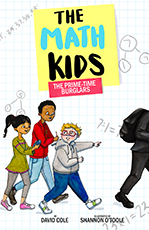Writing A Book Series
- David Cole
- May 7, 2019
- 3 min read

When I was growing up, I couldn’t wait for the next Hardy Boys book to come out. I lived vicariously through the adventures of the two brothers and their detective father. I still have the first fifty-one books in my library, although that leaves me hundreds short of having the whole collection, which went through multiple authors over almost a century. Years later, when I started writing my own books, I knew I wanted to write a series. What I didn’t know at the time was that writing a series can be very different than writing a single book.
There are three general types of series: the serialized epic, the saga, and the continuing adventures. Think of the serialized epic as one really long book—stack those Harry Potter books on top of each other and you’ll get what I mean! In a serialized epic, each book picks up where the last one left off. These types of series allow you to tell a long, often complicated tale that the author couldn’t put into a single book. The books are connected both by the story and the characters.
The saga is very different. Here, the books are based on the same world but may have no character or even chronological connections. The dragonriders of Pern series fits into this category. Each book is set on the planet of Pern but the focus of each book shifts both in time and characters.
Finally, there is the continuing adventures series. The Hardy Boys fit well into this category. Each book stands on its own, but they are intended to be read chronologically and follow the same cast of characters in their adventures.
As a reader, there is much to love in a series. The characters—or the world in the case of a saga—become familiar friends. We know where they live, who their friends are, and even how they’ll react in certain situations. The stories we love continue to go on, and we hunger for the next episode.
As a writer, a series provides both opportunity and challenge. The opportunity is to really get into the story. The Harry Potter books span seven books and more than 4,100 pages, which gave JK Rowling plenty of time and space to tell the complicated tale of Harry’s life at Hogwarts. It also presented difficult challenges. At the macro level, she needed to think through the entire story ahead of time—what was the story she wanted to tell and how could she break that down into book-sized chunks? At a micro level, she needed to worry about continuity and consistency. The story had to flow smoothly with no plot gaps, and the characters needed to act in a consistent manner while still being allowed to grow.
In many ways, the continuing adventure series, such as The Math Kids series, is much easier for a writer. While the books are chronological and events and characters carry over from book to book, I don’t need to think about book six while I’m writing book one. I have the luxury of looking at where I’m going with the series without getting locked into a specific direction. That allows me to concentrate on one book at a time. In The Math Kids series, each book is focused on a primary math theme—The Prime-Time Burglars, for example, makes heavy use of prime numbers, while A Sequence of Events introduces the Fibonacci series. But, while each book stands alone, the series allows me to have the characters grow. I can expose more of their personalities over the course of multiple books. In each book we learn more about Justin, Stephanie, Jordan, and Catherine. What motivates them? What are their strengths and weaknesses? How do their personal interactions change over time? The continuing adventure series format also gives me a chance to explore more overarching themes and storylines that might carry over from one book to another. The introduction to Agent Carlson in A Sequence of Events leads into the math kids getting involved with an FBI cold case in An Unusual Pattern.
I often think back to my youth and reading those Hardy Boy books. My biggest hope is that someday someone will be looking back on The Math Kids series with that same fond remembrance.
The Math Kids: A Sequence of Events hits shelves on May 15.






Comments